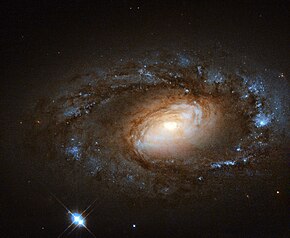NGC 4102 is an intermediate[9] barred spiral galaxy located in the northern constellation of Ursa Major. It is visible in a small telescope and has an apparent visual magnitude of 11.2.[7] The galaxy was discovered April 12, 1789 by William Herschel. J. L. E. Dreyer described it as "bright, pretty small, round, brighter middle and bright nucleus".[11] This galaxy is located at a distance of 60[5] million light years and is receding with a heliocentric radial velocity of 837 km/s.[4] It is a member of the Ursa Major group of galaxies.[6]
| NGC 4102 | |
|---|---|
 NGC 4102 image taken by the Hubble Space Telescope | |
| Observation data (J2000 epoch) | |
| Constellation | Ursa Major[1] |
| Right ascension | 12h 06m 23.115s[2] |
| Declination | +52° 42′ 39.42″[2] |
| Redshift | 0.002792[3] |
| Heliocentric radial velocity | 837 km/s[4] |
| Distance | 59.6 Mly (18.3 Mpc)[5] |
| Group or cluster | Ursa Major group[6] |
| Apparent magnitude (V) | 11.2[7] |
| Apparent magnitude (B) | 11.8[8] |
| Characteristics | |
| Type | SAB(s)b,[9][10] SABab[3] |
| Apparent size (V) | 2.9′ × 1.8′[7] |
| Notable features | LINER[9] |
| Other designations | |
| IRAS 12038+5259, 2MASX J12062311+5242394, WISE J120623.07+524239.8, UGC 7096, LEDA 38392, MCG MCG+09-20-094, PGC 38392, SDSS J120623.00+524240.1[8] | |
The morphological class of NGC 4102 is SABab[3] or SAB(s)b?,[10] which is a spiral galaxy with a bar-like feature around the core (SAB), no inner ring structure (s), and moderately tightly-wound spiral arms ('ab' or 'b'). However, the bar in this galaxy is considered particularly small for galaxies of this class.[10] The galactic plane is inclined at an angle of 56°±2° to the line of sight from the Earth.[12] NGC 4102 has a region of intense star formation in the nuclear region, known as a starburst region.[6] This volume is 1,000 ly (310 pc) in diameter containing some 3 billion solar masses.[13] An outflow of hydrogen has been detected, extending outward to the northwest as far as 6.3 kpc (21 kly) from the nucleus.[14]
The core of NHC 4102 is almost certainly an active galactic nucleus (AGN),[15] which indicates it has a supermassive black hole (SMBH) that is generating energy by accreting material.[16] It is an X-ray source with a spectrum similar to a Seyfert 2 galaxy.[15] This type of AGN is known as a Type-2 LINER, or low-ionization nuclear emission-line region. This is due to a core that is obscured by intervening dusty materials and/or the SMBH is accreting material in an inefficient manner. The bolometric luminosity of the active nucleus is ~7×1043 erg·s−1.[16]
One supernova has been observed in NGC 4102: SN 1975E (type unknown, mag. 16.7).[17]
References
External links
 Media related to NGC 4102 at Wikimedia Commons
Media related to NGC 4102 at Wikimedia Commons
